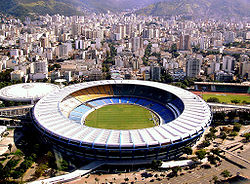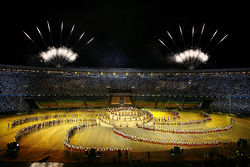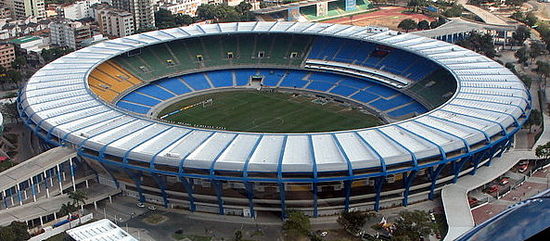Estádio do Maracanã
| Estádio do Maracanã | |
|---|---|
 |
|
| Full name | Estádio Jornalista Mário Filho |
| Location | Rio de Janeiro, Brazil |
| Broke ground | August 2, 1948 |
| Opened | June 16, 1950 |
| Renovated | 2007 |
| Owner | Rio de Janeiro State Government |
| Surface | Grass |
| Architect | Waldir Ramos Raphael Galvão Miguel Feldman Oscar Valdetaro Pedro Paulo B. Bastos Orlando Azevedo Antônio Dias Carneiro |
| Capacity | 82,238[1] |
| Field dimensions | 110 x 75 m |
| Tenants | |
| Flamengo Fluminense Vasco (for derbies) 2016 Summer Olympics |
|
The Estádio do Maracanã (Brazilian Portuguese: [eʃˈtadʒju du maɾakɐˈnɐ̃]), officially Estádio Jornalista Mário Filho, is an open-air stadium in Rio de Janeiro, Brazil. Owned by the Rio de Janeiro State Government, it is named after the Maracanã neighbourhood in Rio de Janeiro. It was opened in 1950 to host the FIFA World Cup, and in the final game Brazil was beaten 2-1 by Uruguay. Since then, it has mainly been used for football matches between the major football clubs in Rio de Janeiro, including Botafogo, Flamengo, Fluminense and Vasco da Gama. It has also hosted a number of concerts and other sporting events. Although the paid attendance at the final game of the 1950 FIFA World Cup was 199,854, the stadium currently seats 82,238 spectators.[2] It was the main venue of the 2007 Pan American Games, hosting the football final, and the opening and closing ceremonies.
Over time, however, the stadium also has become a multi-character space to receive other events such as shows and games from other sports, such as volleyball. After several works of modernization, the current capacity of the stadium is 82,238 spectators, making it the largest stadium in Brazil and South America.
In 2010 the Maracanã will be closed for renovations and upgrade of total capacity to around 90,000 spectators in preparations for the 2014 World Cup and the 2016 Summer Olympics/Paralympics as it will be the main stadium in both events.
Contents |
Name
The official name of the stadium, Mário Filho, was given in honour of the late carioca journalist, brother of Nelson Rodrigues, who stood out in supporting the construction of Maracanã.
But the popular name is derived from the Rio Maracanã, which crosses the Tijuca through St Kitts, flowing in the Mangue Channel before the drainage system in the Guanabara Bay. In Tupi-Guarani the word Maracana means "like a rattle". Due to the construction of the stadium, was created in the Maracanã where the stadium is located was originally part of Tijuca. In this area city there were various birds, coming from Northern Brazil, known as Chestnut-fronted Macaw.
History
Construction and opening
The construction of Maracanã was criticized by Carlos Lacerda, then Congressman and political enemy of the mayor of the city, general Ângelo Mendes de Morais, for the expense and also due to the chosen location for the stadium, arguing that it was built in Jacarepagua. Still, supported by journalist Mário Rodrigues Filho Mendes de Morais, the project went forward. In the chosen field, stood an arena for the horse race. The competition for the works was opened by municipality of Rio de Janeiro in 1947, With the project architectural winner is presented by Michael Feldman, Waldir Ramos, Raphael Galvão, Oscar Valdetaro, Orlando Azevedo, Pedro Paulo Bernardes Bastos, Antônio Dias Carneiro. The works commenced in August 2, 1948, the launch date of cornerstone. 1,500 workers constructed the stadium, having added these two thousand in the last months of work. Despite having come into use in 1950, the works were only completed in 1965.
The stadium's inauguration took place with the completion of a friendly football match between teams of Rio de Janeiro and São Paulo on June 16 of 1950, São Paulo won by 3 to 1. Midfielder Didi was the first author of a goal in the stadium.
World Cup 1950
Built for the 1950 World Cup, the Maracanã's first official match was in that competition on June 24, 1950. The game saw Brazil defeat Mexico 4-0, with two goals from Ademir and one each from Baltasar and Jair. The match was refereed by Englishman George Reader.
Five of Brazil's six games at the tournament were played at the Maracanã (the exception being their 2-2 draw with Switzerland). For the final, 199,854 fans were officially registered (with 173,850 paying). Brazil were beaten 2-1 by Uruguay. This defeat on home soil is a significant event in Brazilian history, being known popularly as the Maracanazo.
Construction
After winning the right to host the 1950 FIFA World Cup, the Brazilian government sought to build a new stadium for the tournament. The plans for the stadium were drawn up by seven Brazilian architects, Miguel Feldman, Waldir Ramos, Raphael Galvão, Oscar Valdetaro, Orlando Azevedo, Antônio Dias Carneiro and Pedro Paulo Bernardes Bastos.[3] The first stone was laid at the site of the stadium on August 2, 1948.[4] With the first World Cup game scheduled to be played on June 24, 1950, this left a little under two years to finish construction. However, work quickly fell behind schedule, prompting FIFA to send Dr. Ottorino Barassi, the head of the Italian FA, who had organized the 1934 World Cup to help in Rio de Janeiro.
Opening
The opening match of the stadium took place on June 16, 1950. Rio de Janeiro All-Stars beat São Paulo All-Stars 3-1; Didi became the player to score the first ever goal at the stadium.[5] Despite hosting a match, the stadium was still unfinished. It lacked toilet facilities and a press stand, and still looked like a building site. It was said that the stadium could house 200,000 standing spectators, making it one of the largest stadiums in the world at the time. Despite the stadium's unfinished state, FIFA allowed matches to be played at the venue, and on June 24, 1950, the first World Cup match took place. Brazil beat Mexico with a final score 4-0, with Ademir becoming the first scorer of a competitive goal at the stadium with his 30th minute strike. 81,000 spectators attended the game. Eventually, Brazil progressed to the final round, facing Uruguay in the final match of the tournament on July 16, 1950. Brazil only needed a draw to finish top of the group, but Uruguay won the game 2-1, shocking the thousands who attended the game. This match has since been known as the "Maracanazo". The official attendance of the game was 199,854, with the actual attendance estimated to be about 210,000.[6][7]
Post World Cup years
On March 21, 1954 a new official attendance record was set in the game between Brazil and Paraguay, after 183,513 spectators entered the stadium with a ticket and 177,656 in Fla-Flu (1963). In 1963, stadium authorities replaced the square goal posts with round ones, but it was still two years before the stadium would be fully completed. In 1965, 17 years after construction began, the stadium was finally finished.
Since the World Cup left Brazil in 1950, the Maracanã Stadium has mainly been used for club games involving four major football clubs in Rio— Vasco, Botafogo, Flamengo and Fluminense. The stadium has also hosted numerous domestic football cup finals, most notably the Copa do Brasil and the Campeonato Carioca.
In September 1966, Mário Filho, a Brazilian journalist, columnist and sports figure, died, leading to the administrators of the stadium renaming the stadium after him to Estádio Jornalista Mário Filho. However, the nickname of Maracanã continued to be used. Mario Filho was a prominent campaigner who was largely responsible for the stadium originally being built. In 1969, Pelé scored the 1,000th goal of his career at the Maracanã against Vasco in front of 125,000 spectators. In 1989, Zico scored his final goal for Flamengo at the Maracanã, taking his goal tally at the stadium to 333, a record that still stands as of 2007.
Modern day
On July 19, 1992, an upper stand in the stadium collapsed, leading to the death of three supporters and 50 more being injured.[8] Following the disaster, the stadium's capacity was greatly reduced as it was converted to an all-seater stadium in the late 1990s. Despite this, the ground was classified as national landmark in 1998, meaning that it could not be demolished. The stadium hosted the first ever FIFA Club World Cup final match between Vasco da Gama and Corinthians, which Corinthians won on penalties.
Following its 50th anniversary in 2000, the stadium underwent renovations which would increase its full capacity to around 103,000. After years of planning and nine months of closure between 2005 and 2006, the stadium was reopened in January 2007 with an all-seated capacity of 82,238.
The stadium is part of a complex that includes an arena known by the name of Maracanãzinho, which means "the Little Maracanã" in Portuguese.

Design for the World Cup 2014 and the 2016 Olympic Games
The Maracanã is regarded as one of candidates to host matches at the 2014 World Cup. The intention is that the stadium will be the location of the final match of the competition, becoming the second stadium in the world to host two World Cup finals, the first being the Estadio Azteca in Mexico, which hosted the finals in 1970 and 1986. In 2016 it will become the sixth stadium to host both a World Cup final and the Opening/Closing ceremonies of the Olympics, after the old Wembley in London, host of the 1948 Olympics and 1966 World Cup Final; Stade Olympique in Paris, host of the 1924 Olympics and the 1938 World Cup Final; Olimpico Rome, host of the 1960 Olympics and 1990 World Cup Final; Munich's Olympic Stadium which hosted the Olympics in 1972 and the World Cup Final in 1974 and Berlin's Olympic Stadium, host of the 1936 Olympics and the 2006 World Cup Final (though it was thoroughly redesigned and renovated between the two events). Estadio Azteca and USA's Rose Bowl were Olympic venues but not the main stadium.
For the World Cup in 2014, it is running a project that increases the expansion of the stadium roof, which will be covering all the seats, which is not true today, where protection is given from the seats of the bleachers above the gate access of each sector. In addition, the grayish tone returns to the main color of the stadium, the current sector blue chairs will be demolished, giving way to a new lower bleachers. The boxes, installed above the bleachers for the 2000 FIFA Club World Cup, will also be demolished and replaced with a new grandstand.
The same project also will also renovate the stadium to host the opening and closing ceremonies and the football finals at the 2016 Summer Olympics.
Non-footballing events

- Pope John Paul II celebrated masses at the stadium.
- In 1980 and 1983, volleyball matches between Brazil and the USSR played at the ground.
- To celebrate the 30th anniversary of the stadium, on January 26, 1980, Frank Sinatra performed to a crowd of 180,000.[9]
- Both Tina Turner and Paul McCartney made the Guinness Book of World Records with performances at the stadium. Both concerts, on 1988 (Break Every Rule Tour) and April 1990 (Flowers in the Dirt world tour), respectively, attracted crowds of over 180,000 people.[10][11]
- From January 18 to 27, 1991, the stadium hosted the second edition of Rock in Rio, with Prince, Guns N' Roses, George Michael, INXS, a-ha and New Kids on the Block as headliners.
- The January 1995 edition of the Hollywood Rock festival consisted of two successive concerts by The Rolling Stones at the stadium.
- Sting and Madonna are the only international popstars to have played dates at Maracanã on distinct occasions. Sting opened his ...Nothing Like the Sun world tour at the stadium on November 20, 1987. Approximately 20 years later, on December 8, 2007, he performed there again with The Police. Madonna played the venue on November 6, 1993, with the Girlie Show spectacle, and then again 15 years later on December 14 and 15, 2008, as part of the Sticky & Sweet Tour.
- Rush, Kiss, Backstreet Boys and RBD also played the venue. Rush's concert is documented on their live album Rush in Rio. Brazilian artists also played at the stadium, like Ivete Sangalo, Sandy & Junior and, most recently, Roberto Carlos.
- The stadium hosted the opening and closing ceremonies of the XV Pan American Games.
- The Jonas Brothers are scheduled to perform here on November 7, 2010 for their World Tour.
- The stadium will host the Opening and Closing Ceremonies of the 2016 Summer Olympics and 2016 Summer Paralympics.

References
- ↑ [1]
- ↑ Cadastro Nacional de Estádios de Futebol
- ↑ "El fútbol vuelve al histórico Maracaná tras nueve meses de espera" (in Spanish). El País. 2006-01-22. http://www.elpais.com.uy/06/01/22/ultmo_197140.asp. Retrieved 2008-10-20.
- ↑ "Soccer Hall: 1950 FIFA World Cup". soccerhall.org. http://national.soccerhall.org/history/WorldCup_1950.htm. Retrieved 2007-03-23.
- ↑ "Sambafoot.com: Maracanã, the largest stadium of the world". Sambafoot.com. http://www.sambafoot.com/en/articles/30_Maracana_the_largest_stadium_of_the_world_page_1.html. Retrieved 2007-03-23.
- ↑ "Futebol; the Brazilian way of life". http://www.ofutebol.com/excerpt.shtml. Retrieved 2007-03-23.
- ↑ "Sambafoot.com: Maracanã, the largest stadium of the world". sambafoot.com. http://www.sambafoot.com/en/articles/30_Maracana_the_largest_stadium_of_the_world_page_2.html. Retrieved 2007-03-23.
- ↑ "Sports Disasters". http://www.emergency-management.net/sport_ev.htm. Retrieved 2007-03-23.
- ↑ ">Х> FRANK SINATRA - Era uma vez um mito chamado Frank Sinatra >". Duplipensar.Net. http://www.duplipensar.net/artigos/2005-Q4/era-uma-vez-mito-chamado-frank-sinatra.html. Retrieved 2009-05-26.
- ↑ Jet February 8, 1988 - Vol. 73, n. 19, p.60. ISSN 0021-5996
- ↑ "One Year Ago: Internet Gives McCartney All-Time Largest Album Promo". E-Commerce Times. December 14, 2000. http://www.ecommercetimes.com/story/6078.html. Retrieved 9 March 2010.
External links
- (Portuguese) Official Maracanã website
- Photo Gallery of Museum and Game @ The Rio de Janeiro Photo Guide
|
||||||||||||||||||||||||||||||||||||||||||||||||||||||||